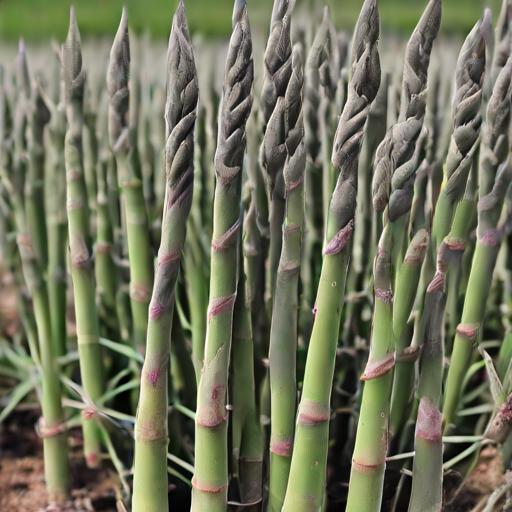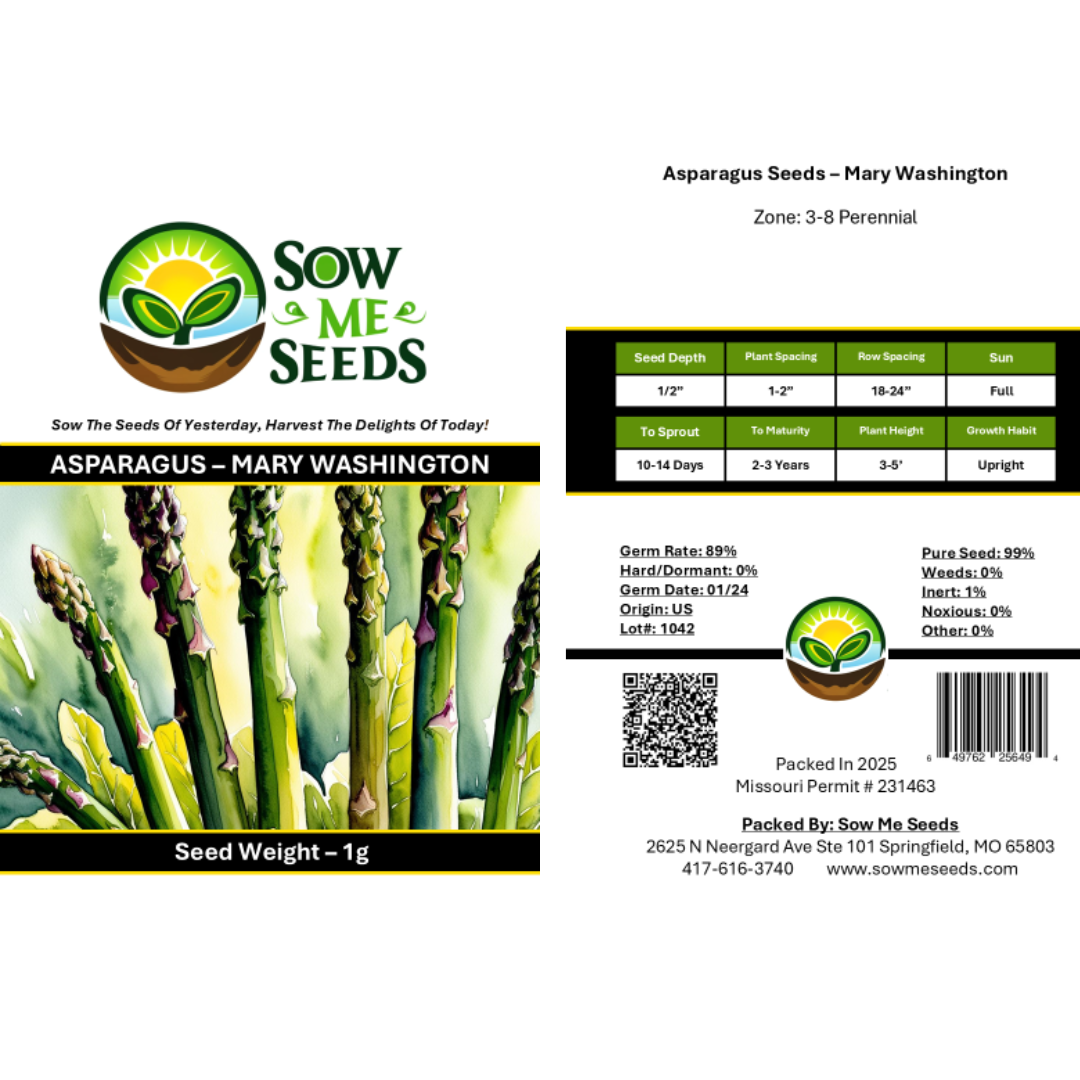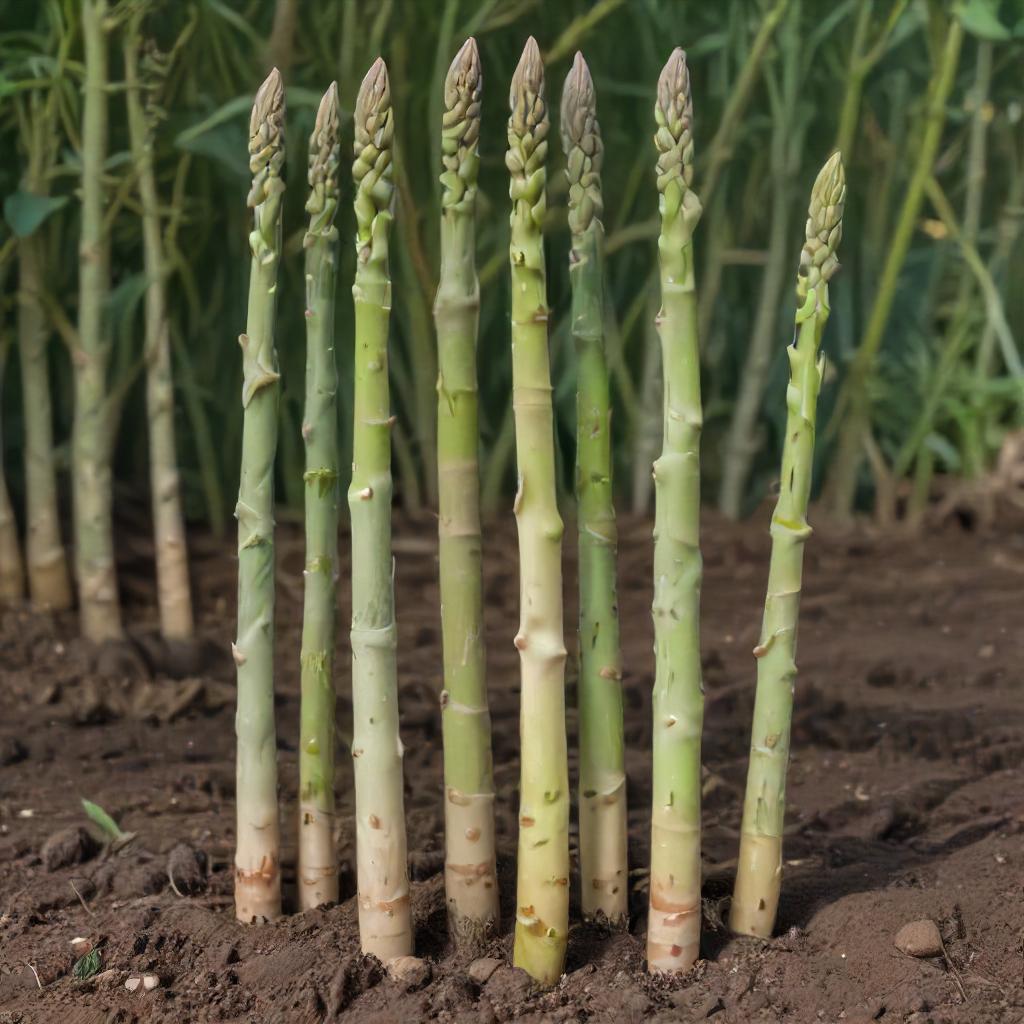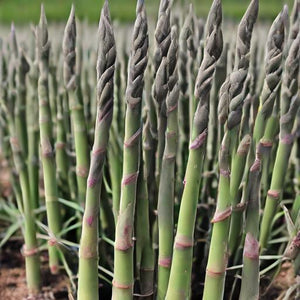- Hardiness Zone: 3-8 Perennial
Seed Depth: 1/2–1 inch
Seed Spacing: 12–18 inches
Row Spacing: 4–5 feet
Sunlight: Full sun
Days to Sprout: 10–20 days
Days to Maturity: 2–3 years (established perennial)
Growth Habit: Upright, Perennial
Sunlight: Select a sunny location that receives at least 6-8 hours of direct sunlight daily.
Soil: Prefers well-drained, sandy loam soil rich in organic matter with a pH between 6.5 and 7.5. Amend the soil with compost or aged manure to improve fertility and drainage.
When to Plant: Asparagus is best planted in early spring as soon as the soil can be worked. Planting crowns (1-year-old plants) is the most common method, but you can also start from seeds if you have more time and patience.
Starting Indoors: Start seeds indoors 12-14 weeks before the last frost date. Sow seeds 1/2 inch deep in seed-starting mix. Keep the soil moist and maintain a temperature of 70-75°F (21-24°C). Transplant seedlings outdoors after the danger of frost has passed.
Direct Sowing: Sow seeds directly in the garden in early spring. Thin seedlings to 12-18 inches apart once they are a few inches tall.
Succession Planting: Not applicable; asparagus is a perennial that will produce for up to 20 years with proper care.
Watering: Keep the soil consistently moist, especially during the first two years of growth. Water deeply and regularly, providing about 1-2 inches of water per week. Mulch around the plants to retain moisture and suppress weeds.
Fertilization: Fertilize asparagus in early spring and again after the harvest season. Use a balanced fertilizer or compost to provide essential nutrients. Avoid over-fertilizing, as this can lead to excessive fern growth at the expense of spear production.
Mulching and Weeding: Apply a thick layer of mulch to suppress weeds and retain soil moisture. Keep the asparagus bed weed-free, especially during the establishment phase, to reduce competition for nutrients and water.
Pest and Disease Management: Asparagus is relatively pest and disease-resistant. However, watch for asparagus beetles and rust. Hand-pick beetles and use organic pest control methods if necessary. Ensure good air circulation and avoid overhead watering to prevent fungal diseases.
Fern Care: Allow the asparagus ferns to grow after the harvest season to nourish the crowns for next year’s crop. Cut back the ferns to the ground in late fall or early spring before new growth begins.
Pruning: Cut back fern-like foliage to the ground in late fall after it turns yellow to prevent disease.
When to Harvest: Do not harvest asparagus during the first two years after planting crowns or the first three years if starting from seeds. This allows the plants to establish a strong root system. Begin harvesting in the third year for crowns and the fourth year for seeds. Harvest spears when they are 6-8 inches tall and about the diameter of your pinky finger.
How to Harvest: Use a sharp knife or asparagus harvester to cut the spears at or just below the soil surface. Harvest regularly every 1-3 days during the 4-6 week harvest period to encourage continuous production.
Storing Fresh Asparagus: Freshly harvested asparagus can be stored in the refrigerator for up to a week. Place the spears upright in a container with a small amount of water or wrap the cut ends in a damp paper towel and store them in a plastic bag.
Culinary Uses: Asparagus is versatile and can be steamed, boiled, grilled, roasted, or sautéed. It makes a delicious addition to salads, stir-fries, pasta dishes, and as a side dish.
Why You’ll Love It
Perennial Favorite: Once established, this asparagus will produce delicious spears every spring for 15–20 years.
Tender and Tasty: Green spears with tight purple tips are known for their excellent texture and mild, nutty flavor.
Cold Hardy: Tolerates frost and overwinters reliably in zones 3–8.
Low Maintenance: Easy to grow in well-drained soil — gets better with age and minimal care.
Plant Characteristics
Height: 3–5 feet (fern stage)
Growth Habit: Upright perennial with fern-like foliage after harvest season
Spear Type: Green stalks with slightly purple tips
Days to Maturity: Harvest begins in 2–3 years after establishment from seed
Hardiness: Perennial in zones 3–8
Flavor and Culinary Uses
Flavor: Mild, nutty, and slightly sweet with a tender bite
Culinary Uses: Excellent for roasting, grilling, steaming, stir-frying, or adding to quiches and pastas
Companion Planting Tips
Good Companions: Tomatoes, parsley, basil, and marigolds
Avoid Planting Near: Onions, garlic, and other alliums
Bonus Benefit: Asparagus ferns create shade and shelter for pollinators when left to grow after harvest
Common Issues and Solutions
Thin Spears: Avoid harvesting too early in establishment; feed with compost or organic fertilizer
Asparagus Beetles: Remove by hand or apply neem oil if infestation occurs
Weed Competition: Keep beds mulched and weed-free, especially in the first few seasons
Seeds Per Packet
| 1g | Approximately 43 |
| 3g | Approximately 129 |
Why You’ll Love It
Perennial Favorite: Once established, this asparagus will produce delicious spears every spring for 15–20 years.
Tender and Tasty: Green spears with tight purple tips are known for their excellent texture and mild, nutty flavor.
Cold Hardy: Tolerates frost and overwinters reliably in zones 3–8.
Low Maintenance: Easy to grow in well-drained soil — gets better with age and minimal care.
Plant Characteristics
Height: 3–5 feet (fern stage)
Growth Habit: Upright perennial with fern-like foliage after harvest season
Spear Type: Green stalks with slightly purple tips
Days to Maturity: Harvest begins in 2–3 years after establishment from seed
Hardiness: Perennial in zones 3–8
Flavor and Culinary Uses
Flavor: Mild, nutty, and slightly sweet with a tender bite
Culinary Uses: Excellent for roasting, grilling, steaming, stir-frying, or adding to quiches and pastas
Companion Planting Tips
Good Companions: Tomatoes, parsley, basil, and marigolds
Avoid Planting Near: Onions, garlic, and other alliums
Bonus Benefit: Asparagus ferns create shade and shelter for pollinators when left to grow after harvest
Common Issues and Solutions
Thin Spears: Avoid harvesting too early in establishment; feed with compost or organic fertilizer
Asparagus Beetles: Remove by hand or apply neem oil if infestation occurs
Weed Competition: Keep beds mulched and weed-free, especially in the first few seasons
Seeds Per Packet
| 1g | Approximately 43 |
| 3g | Approximately 129 |





Share and get 15% off!
Simply share this product on one of the following social networks and you will unlock 15% off!